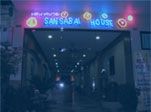|
Huai Yai
Waterfall
Huai Yai
Waterfall is a tourist destination under the care of Thap Lan National
Park. Take Highway No. 304 to the market at Km. 79 for 6 kilometres.
The entrance is a sloped walkway about 20 metres long. You will find a
small waterfall flowing past 2 large boulders. It has water only in
the rainy season around July to September.
Ban Prasat Archaeological Site
The site is
Thailand's second archaeological site (the first was Ban Chiang) to be
set up as an outdoor museum. Findings indicate that the area was once
inhabited by a prehistory to early history community. In addition,
there is evidence that a community of the Dvaravati and Khmer periods
thrived here some 1,500 to 3,000 years ago. There are 3 pits that have
been landscaped and are open to the public. Discoveries of human
skeletons and many pottery pieces that were dug up from various levels
are evidence of human evolution, community beliefs and culture.
To get there
from the city, take Highway No. 2 (Nakhon Ratchasima-Khon Kaen) for 44
kilometers and then turn right and proceed for 1 kilometer. If going
by bus from Bangkok or Nakhon Ratchasima, take a bus bound for Khon
Kaen, Udon Thani, Nong Khai, or Kalasin. Get off at the 44-km marker
and take a hired motorcycle into the village.
Phimai Historical Park
Within the Park is the Phimai Sanctuary, one of the grandest and most
important Khmer historical sites in Thailand.
The word Phimai
appears in an inscription on a stone slab at the front doorway of the
building as well as in many other structures. It is believed that the
word Phimai referred to a religious figure or site.
The Phimai
Sanctuary is rectangular in shape and is 565 meters wide and 1,030
meters long. It consists of ornately carved sandstone and laterite
structures. The most special characteristic of the sanctuary is that
it is the only one that faces south while the others usually face
east. This is probably because it was built to face the route that the
Khmers traveled from the capital of the empire, to the south of
Phimai.
From stone
inscriptions and the architectural style, the Phimai Sanctuary was
most likely built at the end of the 11th century during the reign of
King Suriyaworaman I. The architectural style is that of the Baphuon
style that prospered at the time. However, some characteristics are
similar to that of Angkor Wat, which became popular at a later period.
Some additions were made to the site in the early 18th Buddhist
century during the reign of King Chaiworaman VII when Phimai had close
relations with the Khmer Empire. The sanctuary was always a religious
site of the Mahayana sect of Buddhism because King Suriyaworaman I and
King Chaiworaman VII were followers of the sect.
Important Structures in Phimai Sanctuary:
The Naga Bridge
is the first part you pass when visiting the site. The bridge and lion
figures stand in front of the Gopura (porch) south of the main pagoda.
The intention may have been to build a link between earth and heaven
according to both Hindu and Buddhist beliefs concerning the universe.
The Gopura was
adapted as the wall around the sanctuary and the four entering
porches. There is a large corridor connecting the outer and inner
areas of the main sanctuary. Above each porch is a lintel of various
designs.
The Main Prang
or pagoda is on an open area in a curved walkway. It is the centre of
the site and is made entirely of white sandstone and is different from
the porches and walls that are made primarily of red sandstone. This
is because white sandstone is more durable than red sandstone. The
pagoda is 28 meters high, has a square base, a portico and stairways
and doors in all 4 directions.
The pagoda
consists of a base, outer walls, columns, and porches with beautiful
designs. Of vital importance are the lintels that mostly recount the
tale of Ramayana from Hinduism and tales of the Mahayana sect of
Buddhism. The lintels above the 4 doorways of the main pagodas inner
chamber, the most important room of the pagoda, are all about Buddhism
reflecting the Buddhist influence that eventually surpassed that of
Hinduism. The carvings are of the Baphoun style and the Angkor Wat
style leading to the belief that the main pagoda was built at the end
of the 12th century.
There are other
pagodas, which are Prang Brahmadat in front of the main pagoda, Prang
Hin Daeng and Ho Phram (Brahma Hall) to the right.
The park is
open daily from 7.30 a.m. to 6 p.m. The admission is 40 baht. There
are youth guides available to provide visitors with information about
the site for free.
Historical Sites Outside Phimai Sanctuary:
The Phimai City Gate and City Walls were built during the reign of
King Chaiworaman VII. Of the 4 gates, the south gate is the most
important because the road from the ancient Khmer capital to Phimai
runs through it. The sanctuary can be seen when looking straight
through the gate.
The Men
Brahmadat is southeast of the walls and is made entirely of bricks.
Its present form is a huge and round earth hill that is about 30
meters high. The site is believed to have been the place where a king
was cremated. However, the style of construction suggests it was built
in the late Ayutthaya period.
Other sites to
the south are Tha Nang Sa Phom, Kuti Rusi and Arokhayasan.
page: 1 |
2 | 3
|
Source : Tourism
Authority of Thailand
More Information Please visit
www.tourismthailand.org
|







